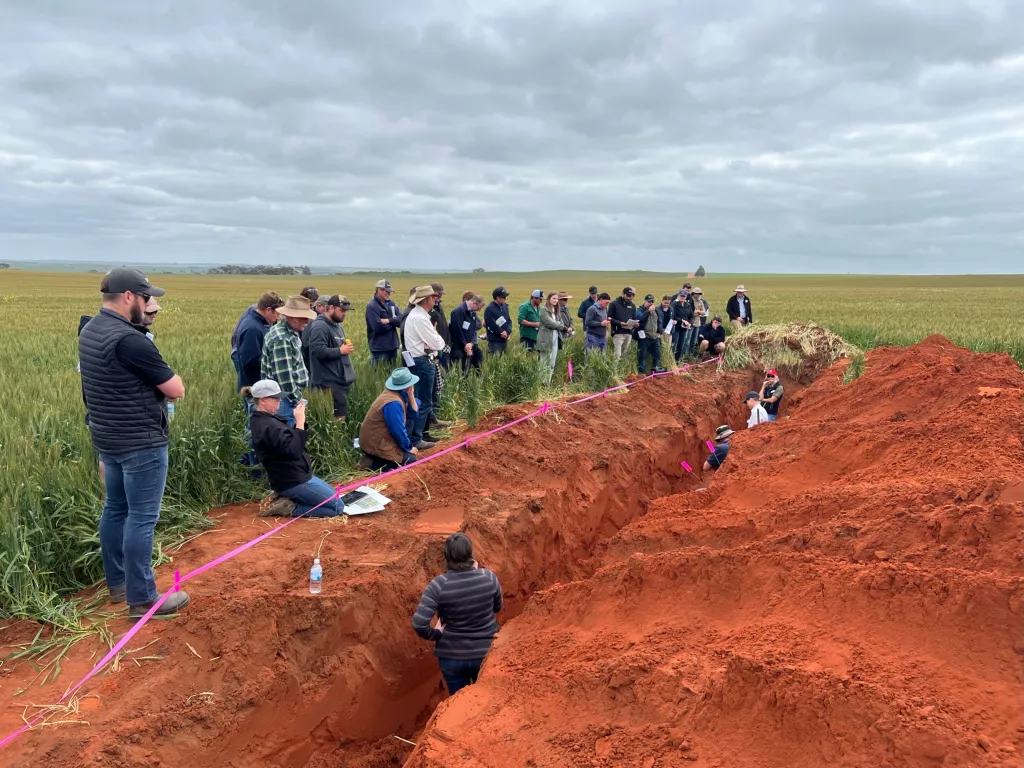Rowes Road Crop Nutrition Tour - Farmer Summary
By Kate Parker, WMG Project Officer

Introduction
The Rowes Road Crop Nutrition Tour occurred on the 1st of August with 22 attendees, a mix of farmers and industry. The tour involved stopping off at three different trial sites along Rowes Road hosted by CSBP and WMG.
Site 1 – CSBP Legume Trial Site (Cahill’s)
The CSBP legume trial site resulted from concerns around declining organic levels in soils and overall sustainability in farming systems. There is a well known limit to productivity in farming operations with no legumes in the system. The trial is looking to build carbon levels and assess the value of adding legumes into a system alongside the impacts of this on fertiliser needs. Lupin, serradella and canola are being assessed for their benefits to agricultural systems with data being collected across multiple seasons/rotations. Initial results are showing crops are more responsive to N with legumes in the system, particularly after amelioration. CSBP emphasises a need for resilience and long term sustainability.

Attendees all had experience with legumes, mostly lupins with some serradella, clover and vetch for stockfeed. General consensus from the group was N applications tend to be the same every year even with additional inputs such as a previous year of legumes or manure applications.
There was discussion around looking into a multiyear cost-benefit analysis and how long benefits from legumes can last. N uptake is dependent on how ‘exhausted’ your soils are of N; Resilience and capturing top yields are important as well as a back end supply of N. Adding lupins into rotation can give a higher ‘natural’ yield for a following crop than with just N applications.
Site 2 – WMG K Cycling Trial Site (Brown’s)

The West Midlands Group K Extension Project is investigating the cycling trial is looking into potassium management, specifically different crops ability to upcycle potassium from deep in the subsoil. The reasoning behind this trial arose from 10 paddocks across the region being soil tested to 90cm and finding stores of potassium at depth, typically below compaction layers in the soil. The trial is looking at 5 different crops replicated 6 times with half the site being deep ripped post seeding to increase crop ability to get roots deeper into the profile.
Attendees discussed the effects of post seeding amelioration on seeding depth and if you could adjust rate and depth to compensate for any effects.
Site 3 – CSBP N Inhibitor Trial Site (Brown’s)
The CSBP inhibitor trial site is comparing different inhibitor products aimed to increase fertiliser use efficiency. Attendees had previously heard of inhibitor products with a handful trialling the practice on their own properties this year for many reasons. The products looked at classified as either volatilisation and/or leaching inhibitors. The products afford growers a larger window for pre-rain application (up to 3 weeks ahead of rain) and can reduce emission intensity for cropping rotations as there is less nitrous oxide emissions.

Attendees discussed the potential economic value of the practice and how to best use these products to boost farm profitability. The inhibitor products were viewed as an ‘insurance’ policy for nitrogen application, essentially a mitigation of risk from rainfall events that do not materialise, the ability to get more area spread between rainfall events, and increase in peace of mind in seasons were leaching and/or volatilisation will be an issue.
Conclusion
The day wrapped up with discussion around each of the stops. The attendees all appreciated the legume site and noted an increased or reinforced view on the value of legumes however deemed there was more work to be done in profitability, marketability and options for the heavy soils prevalent in our area.

The K site sparked interest in post seeding ripping and the feasibility of this practice as an option for dry starts to the season.
Economics was a large subject of conversation across all plots but specifically the N inhibitor site with interest in looking into decisions around granular vs liquid and subsequently spreaders vs sprayers. The N inhibitor site also stimulated talks around conscious decision making around N applications and making them proactively rather than reactively.

WMG CEO Nathan Craig ended the day with a facilitated discussion around turning one percenters into fifteen percenters to increase profit and lower risk alongside how to define what those one percenters to chase are.














